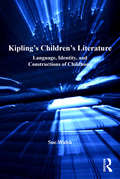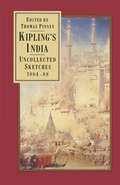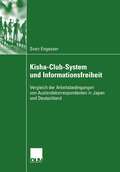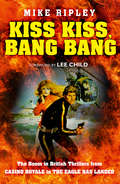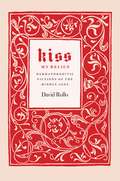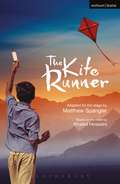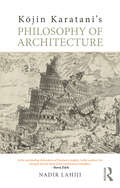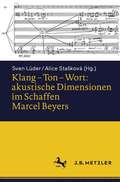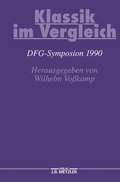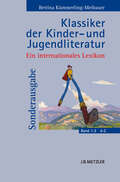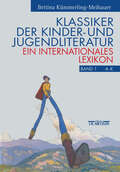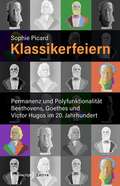- Table View
- List View
Kipling's Children's Literature: Language, Identity, and Constructions of Childhood (Studies in Childhood, 1700 to the Present)
by Sue WalshDespite Kipling's popularity as an author and his standing as a politically controversial figure, much of his work has remained relatively unexamined due to its characterization as 'children's literature'. Sue Walsh challenges the apparently clear division between 'children's' and 'adult' literature, and poses important questions about how these strict categories have influenced critical work on Kipling and on literature in general. For example, why are some of Kipling's books viewed as children's literature, and what critical assumptions does this label produce? Why is it that Kim is viewed by critics as transcending attempts at categorization? Using Kipling as a case study, Walsh discusses texts such as Kim, The Jungle Books, the Just-So Stories, Puck of Pook's Hill, and Rewards and Fairies, re-evaluating earlier critical approaches and offering fresh readings of these relatively neglected works. In the process, she suggests new directions for postcolonial and childhood studies and interrogates the way biographical criticism on children's literature in particular has tended to supersede and obstruct other kinds of readings.
Kipling's Children's Literature: Language, Identity, and Constructions of Childhood (Studies in Childhood, 1700 to the Present)
by Sue WalshDespite Kipling's popularity as an author and his standing as a politically controversial figure, much of his work has remained relatively unexamined due to its characterization as 'children's literature'. Sue Walsh challenges the apparently clear division between 'children's' and 'adult' literature, and poses important questions about how these strict categories have influenced critical work on Kipling and on literature in general. For example, why are some of Kipling's books viewed as children's literature, and what critical assumptions does this label produce? Why is it that Kim is viewed by critics as transcending attempts at categorization? Using Kipling as a case study, Walsh discusses texts such as Kim, The Jungle Books, the Just-So Stories, Puck of Pook's Hill, and Rewards and Fairies, re-evaluating earlier critical approaches and offering fresh readings of these relatively neglected works. In the process, she suggests new directions for postcolonial and childhood studies and interrogates the way biographical criticism on children's literature in particular has tended to supersede and obstruct other kinds of readings.
Kipling’s Imperial Boy: Adolescence and Cultural Hybridity
by D. RandallKipling's Imperial Boy opens by examining the significance of boyhood in the evolution of European modernity. Chapter one shows how closely the figure of the adolescent (the 'boy') is associated with questions of imperial expansion and consolidation. The chapters that follow take up Rudyard Kipling's fiction of the imperial boy, emphasizing the imaginative link between adolescence and cultural hybridity and offering detailed readings of The Jungle Book, Stalky & Co ., and Kim.
Kisha-Club-System und Informationsfreiheit: Vergleich der Arbeitsbedingungen von Auslandskorrespondenten in Japan und Deutschland
by Sven EngesserLässt sich der vermutete negative Einfluss des Kisha-Club-Systems auf die Pressefreiheit in Japan empirisch nachweisen? In einer streng vergleichenden Untersuchung stellt Sven Engesser die Arbeitsbedingungen von Auslandskorrespondenten in Japan und Deutschland einander gegenüber, um den „Kisha-Club-Faktor“ zu bestimmen.
Kiss Kiss, Bang Bang: The Boom In British Thrillers From Casino Royale To The Eagle Has Landed
by Mike RipleyWINNER OF THE HRF KEATING AWARD FOR BEST NON-FICTION CRIME BOOK 2018An entertaining history of British thrillers from Casino Royale to The Eagle Has Landed, in which award-winning crime writer Mike Ripley reveals that, though Britain may have lost an empire, her thrillers helped save the world. With a foreword by Lee Child.
Kiss My Relics: Hermaphroditic Fictions of the Middle Ages
by David RolloConservative thinkers of the early Middle Ages conceived of sensual gratification as a demonic snare contrived to debase the higher faculties of humanity, and they identified pagan writing as one of the primary conduits of decadence. Two aspects of the pagan legacy were treated with particular distrust: fiction, conceived as a devious contrivance that falsified God’s order; and rhetorical opulence, viewed as a vain extravagance. Writing that offered these dangerous allurements came to be known as “hermaphroditic” and, by the later Middle Ages, to be equated with homosexuality. At the margins of these developments, however, some authors began to validate fiction as a medium for truth and a source of legitimate enjoyment, while others began to explore and defend the pleasures of opulent rhetoric. Here David Rollo examines two such texts—Alain de Lille’s De planctu Naturae and Guillaume de Lorris and Jean de Meun’s Roman de la Rose—arguing that their authors, in acknowledging the liberating potential of their irregular written orientations, brought about a nuanced reappraisal of homosexuality. Rollo concludes with a consideration of the influence of the latter on Chaucer’s Pardoner’s Prologue and Tale.
Kiss My Relics: Hermaphroditic Fictions of the Middle Ages
by David RolloConservative thinkers of the early Middle Ages conceived of sensual gratification as a demonic snare contrived to debase the higher faculties of humanity, and they identified pagan writing as one of the primary conduits of decadence. Two aspects of the pagan legacy were treated with particular distrust: fiction, conceived as a devious contrivance that falsified God’s order; and rhetorical opulence, viewed as a vain extravagance. Writing that offered these dangerous allurements came to be known as “hermaphroditic” and, by the later Middle Ages, to be equated with homosexuality. At the margins of these developments, however, some authors began to validate fiction as a medium for truth and a source of legitimate enjoyment, while others began to explore and defend the pleasures of opulent rhetoric. Here David Rollo examines two such texts—Alain de Lille’s De planctu Naturae and Guillaume de Lorris and Jean de Meun’s Roman de la Rose—arguing that their authors, in acknowledging the liberating potential of their irregular written orientations, brought about a nuanced reappraisal of homosexuality. Rollo concludes with a consideration of the influence of the latter on Chaucer’s Pardoner’s Prologue and Tale.
Kiss My Relics: Hermaphroditic Fictions of the Middle Ages
by David RolloConservative thinkers of the early Middle Ages conceived of sensual gratification as a demonic snare contrived to debase the higher faculties of humanity, and they identified pagan writing as one of the primary conduits of decadence. Two aspects of the pagan legacy were treated with particular distrust: fiction, conceived as a devious contrivance that falsified God’s order; and rhetorical opulence, viewed as a vain extravagance. Writing that offered these dangerous allurements came to be known as “hermaphroditic” and, by the later Middle Ages, to be equated with homosexuality. At the margins of these developments, however, some authors began to validate fiction as a medium for truth and a source of legitimate enjoyment, while others began to explore and defend the pleasures of opulent rhetoric. Here David Rollo examines two such texts—Alain de Lille’s De planctu Naturae and Guillaume de Lorris and Jean de Meun’s Roman de la Rose—arguing that their authors, in acknowledging the liberating potential of their irregular written orientations, brought about a nuanced reappraisal of homosexuality. Rollo concludes with a consideration of the influence of the latter on Chaucer’s Pardoner’s Prologue and Tale.
Kiss My Relics: Hermaphroditic Fictions of the Middle Ages
by David RolloConservative thinkers of the early Middle Ages conceived of sensual gratification as a demonic snare contrived to debase the higher faculties of humanity, and they identified pagan writing as one of the primary conduits of decadence. Two aspects of the pagan legacy were treated with particular distrust: fiction, conceived as a devious contrivance that falsified God’s order; and rhetorical opulence, viewed as a vain extravagance. Writing that offered these dangerous allurements came to be known as “hermaphroditic” and, by the later Middle Ages, to be equated with homosexuality. At the margins of these developments, however, some authors began to validate fiction as a medium for truth and a source of legitimate enjoyment, while others began to explore and defend the pleasures of opulent rhetoric. Here David Rollo examines two such texts—Alain de Lille’s De planctu Naturae and Guillaume de Lorris and Jean de Meun’s Roman de la Rose—arguing that their authors, in acknowledging the liberating potential of their irregular written orientations, brought about a nuanced reappraisal of homosexuality. Rollo concludes with a consideration of the influence of the latter on Chaucer’s Pardoner’s Prologue and Tale.
The Kite Runner (Modern Plays)
by Khaled Hosseini Matthew SpanglerI became what I am today at the age of twelve. I remember the precise moment, crouching behind a mud wall on a frigid winter day in 1975 . . . looking into a deserted alley. It's wrong what they say about the past, about how you can bury it, because the past claws its way out. I realize I've been looking into that alley for the last 26 years.Afghanistan is a divided country on the verge of war and two childhood friends are about to be torn apart. It's a beautiful afternoon in Kabul and the skies are full of the excitement and joy of a kite flying tournament. But neither Hassan or Amir can foresee the terrible incident which will shatter their lives forever.Khaled Hosseini's first and international best-selling novel has now been adapted into a stunning stage adaptation by Matthew Spangler.This edition was published for the production at Wyndham's Theatre, London, from 21 December 2016.
The Kite Runner: Based On The Novel By Khaled Hosseini (Modern Plays)
by Khaled Hosseini Matthew SpanglerI became what I am today at the age of twelve. I remember the precise moment, crouching behind a mud wall on a frigid winter day in 1975 . . . looking into a deserted alley. It's wrong what they say about the past, about how you can bury it, because the past claws its way out. I realize I've been looking into that alley for the last 26 years.Afghanistan is a divided country on the verge of war and two childhood friends are about to be torn apart. It's a beautiful afternoon in Kabul and the skies are full of the excitement and joy of a kite flying tournament. But neither Hassan or Amir can foresee the terrible incident which will shatter their lives forever.Khaled Hosseini's first and international best-selling novel has now been adapted into a stunning stage adaptation by Matthew Spangler.This edition was published for the production at Wyndham's Theatre, London, from 21 December 2016.
Kōjin Karatani’s Philosophy of Architecture
by Nadir LahijiIn this book, Nadir Lahiji introduces Kōjin Karatani’s theoretical-philosophical project and demonstrates its affinity with Kant’s critical philosophy founded on ‘architectonic reason’. From the ancient Greeks we have inherited a definition of the word ‘philosophy’ as Sophia—wisdom. But in his book Architecture as Metaphor Kōjin Karatani introduces a different definition of philosophy. Here, Karatani critically defines philosophy not in association with Sophia but in relation to foundation as the Will to Architecture. In this novel definition resides the notion that in Western thought a crisis persistently reveals itself with every attempt to build a system of knowledge on solid ground. This book reveals the implications of this extraordinary exposition. This is the first book to uncover Kōjin Karatani’s highly significant ideas on architecture for both philosophical and architectural audiences.
Kōjin Karatani’s Philosophy of Architecture
by Nadir LahijiIn this book, Nadir Lahiji introduces Kōjin Karatani’s theoretical-philosophical project and demonstrates its affinity with Kant’s critical philosophy founded on ‘architectonic reason’. From the ancient Greeks we have inherited a definition of the word ‘philosophy’ as Sophia—wisdom. But in his book Architecture as Metaphor Kōjin Karatani introduces a different definition of philosophy. Here, Karatani critically defines philosophy not in association with Sophia but in relation to foundation as the Will to Architecture. In this novel definition resides the notion that in Western thought a crisis persistently reveals itself with every attempt to build a system of knowledge on solid ground. This book reveals the implications of this extraordinary exposition. This is the first book to uncover Kōjin Karatani’s highly significant ideas on architecture for both philosophical and architectural audiences.
Klang – Ton – Wort: akustische Dimensionen im Schaffen Marcel Beyers
by Sven Lüder Alice StaškováMarcel Beyer hat mit seinem vielfach ausgezeichneten Schaffen auf einzigartige Weise Grenzbereiche zwischen Literatur, Musik und Kulturtheorie erkundet. Sein Œuvre, das außer Romanen, Gedicht- und Essaybänden auch fünf Libretti umfasst, zeichnet sich durch eine spezifische Aufmerksamkeit für das Akustische aus, wobei Fragen der Darstellung, der Systematisierung und der Performanz stets mitbedacht werden. Auf vielfältige, bislang kaum angemessen ergründete Weise verschränken sich in seinem Schaffen Erfahrungen als Mitwirkender (Sprecher), als Autor von musikbezogenen Essays (v. a. Rezensionen) und als Co-Autor zumal im Musiktheater. Der Band, der auf ein 2019 in Jena veranstaltetes Symposium zurückgeht, enthält Beiträge, die in umfassend interdisziplinärer Weise die Dimensionen des Akustischen in Beyers Werken sowie Ausfaltungen des Dialogs zwischen Musik und Literatur, besonders auch in der Praxis des zeitgenössischen Musiktheaters, untersuchen.
Klassik im Vergleich: DFG-Symposion 1990 (Germanistische Symposien)
Das Klassik-Problem muss stets in seiner Doppelheit von Normativität und Historizität gesehen werden. Erst im Spannungsverhältnis beider Aspekte entsteht der literaturwissenschaftliche Gegenstand Klassik, der in diesem Band anhand verschiedener europäischer Klassiken diskutiert wird.
Klassik und Moderne: Die Weimarer Klassik als historisches Ereignis und Herausforderung im kulturgeschichtlichen Prozeß. Walter Müller-Seidel zum 65. Geburtstag
Klassiker der Kinder- und Jugendliteratur: Ein internationales Lexikon
by Bettina Kümmerling-Meibauer"Emil und die Detektive", "Pippi Langstrumpf" oder "Alice im Wunderland" - wer hat die Klassiker als Kind nicht selbst gern gelesen? Doch wem sind auch "Papelucho", "Kevade" oder "Poil de Carotte" geläufig? Wer sich ausführlich über Inhalt, Bedeutung und Wirkung der international bekannten Kinderbücher kundig machen möchte, sollte in diesem Lexikon nachschlagen. Eine Fundgrube von 534 Kinderbüchern aus über 60 Ländern, davon ein Drittel aus der Zeit nach 1945.
Klassiker der Kinder- und Jugendliteratur: Ein internationales Lexikon. Band 1: A-K, Band 2: L-Z
by Bettina Kümmerling-MeibauerMit diesem Lexikon wird erstmals ein repräsentativer Überblick über ca. 500 klassische Kinder- und Jugendbücher aus über 60 Ländern geboten. Dabei sind nicht nur die allgemein bekannten westeuropäischen und nordamerikanischen Kinder- und Jugendbuchklassiker berücksichtigt, sondern ebenso Beispiele aus den übrigen europäischen Regionen, Afrika, Asien, Südamerika und Australien einschließlich der jeweiligen Minoritätenliteraturen.
Klassikerfeiern: Permanenz und Polyfunktionalität Beethovens, Goethes und Victor Hugos im 20. Jahrhundert (Lettre)
by Sophie PicardIm 20. Jahrhundert wurden die Geburts- und Todestage Beethovens, Goethes und Hugos verlässlich gefeiert, was von der anhaltenden Bedeutung dieser Autoren in einer sich wandelnden Welt zeugt. Sophie Picard fragt nach den Bedingungen für diese Beständigkeit und eröffnet eine neue Perspektive auf das Phänomen Klassik. Ihre Rekonstruktion der Gedenkjahre ermöglicht einen vergleichenden Blick auf den Umgang mit Beethoven, Goethe und Hugo in verschiedenen historischen, kulturellen, diskursiven und medialen Kontexten. Die Vielfalt konkurrierender Funktionalisierungen wird dabei als die Grundlage der Permanenz gedeutet: Die drei Klassiker überdauern den zeitlichen Wandel, weil sie polyfunktional gebraucht werden.
Klassische Texte der spanischen Literatur: 25 Einführungen vom Cid bis Corazón tan blanco
by Hans-Jörg NeuschäferWorum geht es eigentlich in Calderóns La Dama duende ? Wann wurde Don Quijote verfasst? Was ist das Besondere an Corazón tan blanco von Javier Marías? Anschauliche Einführungen fassen die wichtigsten Merkmale zu 25 Hauptwerken der spanischen Literatur zusammen. Neben einer Inhaltsübersicht werden Form, Gestaltung, Entstehungskontext und weitere Hintergründe dargestellt. Interpretationsvorschläge und zahlreiche Beispiele helfen bei der Analyse der Texte. Folgende Texte werden behandelt: Cid; Libro de buen amor; Romancero; La Celestina; Lazarillo; San Juan de la Cruz: Mystische Lyrik; Don Quijote; Funeteovejuna; La dama duende; La vida es sueño; El sí de las niñas; Artículos de costumbres; Canciones; Don Juan Tenorio; Tristana; La Regenta; Campos de Castilla; Niebla; Luces de Bohemia; Cal y Canto; Tres sombreros de copa; La casa de Bernarda Alba; La familia des Pascual Duarte; Corazón tan blanco; El hereje.
Kleine Einführung in die Altertumswissenschaft
by Mary Beard John HendersonDie Autoren dieses Bandes berichten sehr unterhaltsam, unterstützt durch Abbildungen und Cartoons, von dem Entdeckerspaß der Altertumswissenschaftler, aber auch von den Problemen, vor die sie sich bei ihrer Forschung gestellt sehen. Dabei geht es um Kunstraub genauso wie um große Theorien, um moderne Techniken wie um das Beherrschen der alten Sprachen, um das Puzzlespiel der Rekonstruktion wie um das Bild des Altertums im Wandel der Jahrhunderte. Ausgangspunkt sind vereinzelte Stücke eines antiken griechischen Tempels - des Tempels von Bassai -, ausgestellt im Britischen Museum, im Herzen des modernen London.

